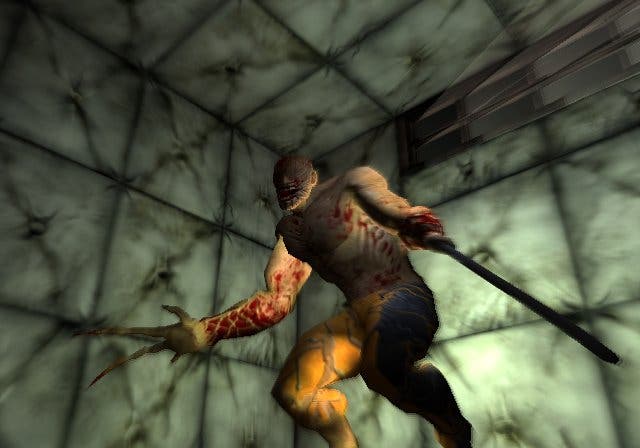The Double A-Team: infernal shiv-em-up The Suffering delivered lurid jailhouse shlock
Do the hokey-chokey.
No-one likes being cooped up: that's why incarceration is such a time-honoured punishment, from medieval oubliettes to the 18th-century panopticon. But when you first meet The Suffering's convict anti-hero Torque - a badass but slyly ironic name considering his taciturn nature - he barely seems to spend any time confined in an actual slammer, despite being jailed for murdering his wife and two kids.
That's because shortly after Torque is frog-marched onto Death Row by a squad of caricatured prison guards, all hell literally breaks loose. This brawny brawler with Wolverine mutton chops is thus abruptly free to run amok through a fetid prison facility sited on a bleak island miles off the coast of Maryland. Navigating via feeble flashlight through the oppressive corridors of Abbott State Penitentiary requires guts and gumption, not least because Torque is tortured by unpredictable visions of his violent past accompanied by the unsettling clamour of a glass harmonium, familiar from dozens of horror movies as sonic shorthand for mental distress.
Is it really freedom if you're surrounded by infernal monsters, most of whom seem to be the offspring of Soulcalibur's circus-tumbling leather-daddy Voldo? You can't say you weren't warned. The Suffering - developed by Surreal Software and published in 2004 by Double-A Team all-stars Midway Games - did not just signal its bellicose intent with that scourging title. There were other clanging clues. The cover art, at least in the UK, featured the disturbing image of an anonymous and clearly doomed convict frantically reaching out through prison bars while an ominous hell-beast loomed behind them.

This was survival horror that refreshingly played by prison rules, where only the strongest and most ruthless would survive. From the moment Torque wields his first improvised shiv, he is at least as deadly as the hellish creatures he faces. Instead of the sneak-and-retreat tactics of Silent Hill and early Resident Evil instalments, this was a psychological chiller that encouraged proactive combat. Rather than withholding ammo, the game soon gifted you a chattering old-school tommy gun (although it also pitted you against a chunky behemoth hefting a cluster of rifle barrels on its powerful back like a saggy set of bagpipes).
As well as scooping up tons of useful ordnance, Torque also possessed the unnatural and unexplained ability to hulk out into a steroidal cenobite at least as bloodthirsty and nightmarish as his opponents. This bizarro duality - plus the ability to toggle between first- and third-person viewpoints at will - added some breadth to what was a fairly narrow campaign, tasking the player with carving a singular path across and under the hardscrabble island to untangle its accursed history of decrepit landmarks, including an abandoned military base, a grand but gloomy asylum and a bustling graveyard.
Appropriately for a game about justice, there was also a morality system at play under the surface: if Torque assisted fellow inmates and panicking corrections officers he was more likely to unlock the happier of three endings. The more immediate pleasures, though, came from mowing down enemies with dual revolvers that sounded like goddamn cannons going off.
The Suffering seemed to beam in from the same lurid noir universe as Max Payne, where burdened sinners exorcised their personal demons via bursts of cathartic ultraviolence while popping illicit pill bottles that rattled like Tic Tacs. Over fifteen years later, it still feels like a genuine B-movie, a gnarly gumbo of grubby violence and muddy graphics. A 2020 remake or remaster that sorted out the queasy aesthetic would be missing the point. It was that visual and moral quagmire that made The Suffering such a breakout hit.









